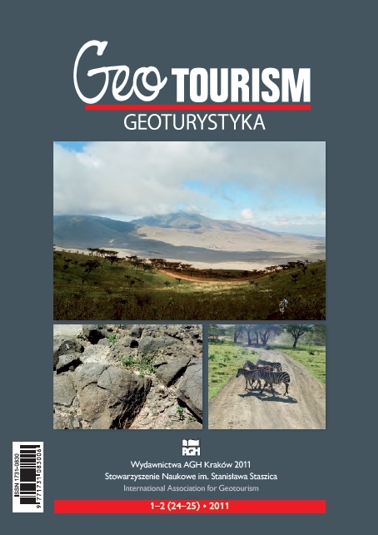The Ngorongoro Crater as the biggest geotouristic attraction of the Gregory Rift (Northern Tanzania, Africa) – geographical setting
DOI:
https://doi.org/10.7494/geotour.2011.24-25.3Keywords:
volcanoes, Ngorongoro, Tanzania, Africa, East African Rift System, Gregory Rift, geotouristc attractionsAbstract
The caldera of an extinct Ngorongoro volcano is the largest unflooded and not destroyed type of this form on Earth. The depression itself occupies an area of nearly 300 km2, while the Crater walls tower a few hundred metres (400–610 m) above the floor of the caldera. Almost all typical for East Africa plants and animals, as well as rare, endemic and often endangered species can be observed in the crater. The unique richness and diversity of natural world of the Ngorongoro Crater is caused exceptionally by favourable weather and hydrological conditions. These factors depend on local conditions, associated with significant relief of this area. Probably, the most important is the richness of the Ngorongoro Crater in water. There occur springs, perennial and seasonal rivers, marshes, swamps, as well as reservoirs of fresh and salty water. Essential is also the presence of the local autochthonous population of the Maasai people, which raises the attractiveness of that localization adding so important cultural values. Due to its unique natural and touristic values, the Ngorongoro Conservation Area (NCA) has been established in 1959. The area was also included into the UNESCO World Cultural and Natural Heritage List. This paper presents only the geographical setting of the Ngorongoro Crater, which should be understood as its morphology, hydrological and climatic conditions, wildlife and indigenous local people.Downloads
References
Anderson, G., Herlocker, D., 1973. Soil factors affecting the distribution of the vegetation types and their utilization by wild animals in Ngorongoro Crater, Tanzania. Journal of Ecology, 61: 627–651.
Dawson, J.B., 2008. The Gregory Rift Valley and Neogene-Recent Volcanoes of Northern Tanzania. Geological Society, London, 102 pp.
Deocampo, D., 2004. Hydrogeochemistry in the Ngorongoro Crater, Tanzania, and the implications for land use in a World Heritage Site. Applied Geochemistry, 19: 755–767.
Deocampo, D., Ashley, G., Copeland, S., 1998. Springs and Streams in an East African Closed Basin: Controls on Biological Communities in Ngorongoro Crater, Tanzania. GSA Abstract Programme, 30, p. 120.
Estes, R.D., Atwood, J.L., Estes, A.B., 2006. Downward trends in Ngorongoro Crater ungulate populations 1986–2005: Conservation concerns and the need for ecological research. Biological Conservation, 131: 106–120.
Estes, R.D., Small, M., 1981. The large herbivore populations of Ngorongoro Crater. African Journal of Ecology, 19: 75–185.
Fishpool, L., Evans, M. (eds.), 2001. Important Bird Areas for Africa and Associated Islands. Priority Sites for Conservation. Pisces Publications and Birdlife International, Newbury and Cambridge, U.K. BLI Conservation Series No.11.
Kangera, R., 2002. Time, life and tides in Ngorongoro Park. Arusha Times, 31 May, Arusha.
Moehlman, P., Amato, G., Runyoro, V., 1996. Genetic and demographic threats to the black rhinoceros population in the Ngorongoro Crater. Conservation Biology, 10 (4): 1107–1114.
Pickering, R., 1994. Ngorongoro’s Geological History. Ngorongoro Conservation Area Authority, Arusha, 52 pp.
Said, M., Chunge, R., Craig, G., Thouless, C., Barnes, R., Dublin H., 1995. African Elephant Database, 1995. IUCN, Gland, Switzerland, 225 pp.
Tombazzi, G., 2003. New map of Ngorongoro Conservation Area. Maco Editions LLC, Italy.
UNESCO/IUCN, 2007. Ngorongoro Conservation Area (United Republic Of Tanzania). Report of the WHC / IUCN Reactive Monitoring Mission May 2007.
UNESCO/IUCN, 2008. Ngorongoro Conservation Area (United Republic Of Tanzania). Report of the WHC / IUCN Reactive Monitoring Mission May 2008.
Żaba, J., 2005. The Kilimanjaro Volcano – geotouristic attraction in Africa. Geotourism, 1 (2): 3–12.
Żaba, J. Gaidzik, K., 2011a. The Ngorongoro Crater as the biggest geotouristic attraction of the Gregory Rift (Northern Tanzania, Africa) – geological heritage. Geotourism, 1–2 (24–25): 27–46.
Żaba, J., Gaidzik, K., 2011b. The Ngorongoro Crater as the biggest geotouristic attraction of the Gregory Rift (Northern Tanzania, Africa) – geotouristic valorization, touristic development and hazard. Geotourism, 1–2 (24–25): 47–64.
http://earthobservatory.nasa.gov/IOTD/view.php?id=4705
http://earthobservator y.nasa.gov/ Newsroom/NewImages/images.php3?img_id=17196
www.ngorongorocrater.org/welcome.html
www.iucnredlist.org/
Downloads
Issue
Section
License

The content of the journal is freely available according to the Creative Commons License Attribution 4.0 International (CC BY 4.0).


